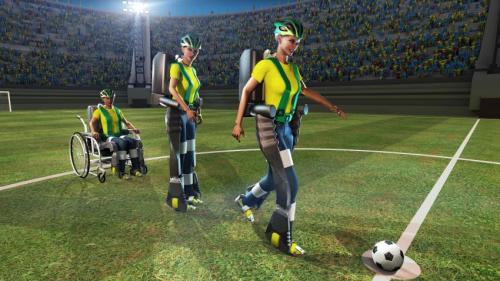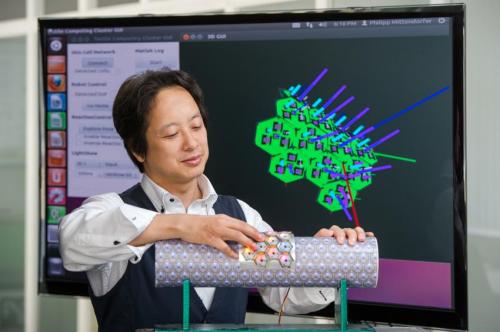"Everything" for a paralyzed person to start the World Cup
On June 12, during the opening of the FIFA World Cup 2014 in Brazil, a paralyzed man wearing a special brain-controlled exoskeleton, is expected to make the first kick of the football championship.

The event is a kind of demonstration of neuroscience and cognitive technology in action. The “Go Again” project is the result of international collaboration of more than 100 scientists from around the world, led by Professor Miguel Nicolelis of Duke University and the International Institute of Neuroscience of Natal in Brazil. The lead partner is Professor Gordon Cheng, head of the Institute for Cognitive Systems at the Technical University of Munich (TUM).
')
Eight patients from Brazil, men and women from 20 to 40 years old who are paralyzed below the belt, were trained for several months to use the exoskeleton. The system works by recording electrical activity in the patient's brain, recognizing his or her intention — for example, taking a step or kicking a ball — and translates this intention into action. The patient also receives tactile feedback using sensitive artificial skin, created by the Cheng Institute.
The development of the project “Walk Again” was the result of cooperation in 2008. Cheng summarizes this collaboration as follows: "Miguel set a monkey walking on a treadmill in North Carolina, and then I made my humanoid robot, who walked with a signal to Kyoto." It was a small, short step for researchers to imagine a paralyzed person walking with a robotic exoskeleton who could control his actions with his mental activity.

“Our brains are very adaptive to how we can expand our perception of using different tools,” says Cheng, “for example, when driving a car or eating chopsticks. After the experiment in Kyoto, we were confident that the brain could also release a paralyzed person, give him the opportunity to walk using the external body. ” It was clear that technical advances would have to allow a relatively compact, easy-to-assemble exoskeleton, and that visual feedback would not be enough. It was also clear that touch would be important for the patient's emotional comfort, as well as for controlling the exoskeleton. Thus, the task was the following: in addition to being able to walk, give the paralyzed person a feeling of touching the ground.
After joining the Technical University of Munich in 2010, Cheng made a priority of his institute - research on the improvement of tactile sensing technology for robotic systems. As a result, the developed system, called CellulARSkin, provides the basis for a reliable and self-organizing sensor network.
The main part is a flat, hexagonal package of electronic components, including a low-power microprocessor, as well as sensors that detect pre-contact, pressure, vibration, temperature, and even movement in three-dimensional space. Any number of these individual "cells" can be combined into a network of cellular location, protected in the current prototype using rubber skin molded elastomer.

“It's not just a sensor,” says Cheng. "Sensor intelligence is more important." The interaction of network cells, and the interaction of the network and the central system, allows the CellulARSkin system to customize itself for each specific application and automatically recover from certain types of damage. These capabilities provide advantages in providing “intelligence”, a safer machine interaction with people.
At the opening of the World Cup, Cheng views this event as a public demonstration of what science can do for people. “In addition, I see this as a great reward for the hard work of patients and their courage!” Says Cheng.
Information taken from phys.org.
Translation and article prepared by the Telebreeze Team
Our Facebook and Twitter page

The event is a kind of demonstration of neuroscience and cognitive technology in action. The “Go Again” project is the result of international collaboration of more than 100 scientists from around the world, led by Professor Miguel Nicolelis of Duke University and the International Institute of Neuroscience of Natal in Brazil. The lead partner is Professor Gordon Cheng, head of the Institute for Cognitive Systems at the Technical University of Munich (TUM).
')
Eight patients from Brazil, men and women from 20 to 40 years old who are paralyzed below the belt, were trained for several months to use the exoskeleton. The system works by recording electrical activity in the patient's brain, recognizing his or her intention — for example, taking a step or kicking a ball — and translates this intention into action. The patient also receives tactile feedback using sensitive artificial skin, created by the Cheng Institute.
The development of the project “Walk Again” was the result of cooperation in 2008. Cheng summarizes this collaboration as follows: "Miguel set a monkey walking on a treadmill in North Carolina, and then I made my humanoid robot, who walked with a signal to Kyoto." It was a small, short step for researchers to imagine a paralyzed person walking with a robotic exoskeleton who could control his actions with his mental activity.

“Our brains are very adaptive to how we can expand our perception of using different tools,” says Cheng, “for example, when driving a car or eating chopsticks. After the experiment in Kyoto, we were confident that the brain could also release a paralyzed person, give him the opportunity to walk using the external body. ” It was clear that technical advances would have to allow a relatively compact, easy-to-assemble exoskeleton, and that visual feedback would not be enough. It was also clear that touch would be important for the patient's emotional comfort, as well as for controlling the exoskeleton. Thus, the task was the following: in addition to being able to walk, give the paralyzed person a feeling of touching the ground.
After joining the Technical University of Munich in 2010, Cheng made a priority of his institute - research on the improvement of tactile sensing technology for robotic systems. As a result, the developed system, called CellulARSkin, provides the basis for a reliable and self-organizing sensor network.
The main part is a flat, hexagonal package of electronic components, including a low-power microprocessor, as well as sensors that detect pre-contact, pressure, vibration, temperature, and even movement in three-dimensional space. Any number of these individual "cells" can be combined into a network of cellular location, protected in the current prototype using rubber skin molded elastomer.

“It's not just a sensor,” says Cheng. "Sensor intelligence is more important." The interaction of network cells, and the interaction of the network and the central system, allows the CellulARSkin system to customize itself for each specific application and automatically recover from certain types of damage. These capabilities provide advantages in providing “intelligence”, a safer machine interaction with people.
At the opening of the World Cup, Cheng views this event as a public demonstration of what science can do for people. “In addition, I see this as a great reward for the hard work of patients and their courage!” Says Cheng.
Information taken from phys.org.
Translation and article prepared by the Telebreeze Team
Our Facebook and Twitter page
Source: https://habr.com/ru/post/226007/
All Articles